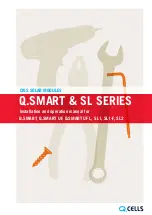
15
INSTALLATION AND OPERATION MANUAL FOR CIGS SOLAR MODULES Q-CELLS SE
7 CLEANING AND MAINTENANCE
Q-Cells CIGS modules are built to last and require minimal maintenance. Light dirt is typically
washed away by rain. However, precipitation may not adequately clear more stubborn grime
(i.e. pollen, vegetation, bird droppings, etc.). Such contamination which shades the active area
of the module can lead to a reduction in its performance.
WARNING! Danger of injury from heated and live modules!
Only clean the modules when the module temperature lies between 10 °C and 30 °C, e.g. in
the early morning or late evening. Do not carry electrically conductive parts.
WARNING! Risk of falling during maintenance of roof installations and building-integrated installations!
Never enter the installation area alone and unsecured. We recommend commissioning a spe-
cialist company to perform this work. Consult your installer on location.
As the operator, you should regularly remove contamination from the modules. In addition to
the safety instructions and chapter 3, observe the following points:
•
Never step on the modules. Do not subject the modules to mechanical stress.
•
Avoid cleaning with water when there is a danger of frost and strong temperature
differences between the module, water and air.
• Hard water used as a cleaning agent should be decalcified beforehand in order to avoid
water staining. Remove any standing water from the module.
•
Do not use abrasive detergents or surface-active agents (e.g. soap). Do not scratch dirt off.
This can damage the surface of the module.
Only remove snow and ice without exerting force (e.g. with a broom).
Proceed as follows to remove dirt from the
top of the module
:
1. Rinse coarse dirt (dust, leaves, etc.) from the module with lukewarm water.
2. Moisten stubborn stains and remove them carefully.
Use lukewarm water and a soft cloth or sponge. If necessary, it is possible to use isopropanol
(IPA)
selectively
. Follow the safety instructions on the IPA packaging. Ensure that the IPA does
not run off between the module and the frame or into the module edges.
Free the
substructure
of dirt (leaves, bird nests, etc.). In the case of ground-mounted installa-
tions, we recommend regularly trimming of the vegetation order to avoid partial shadowing. Be
sure to pay attention to the cables and stones.
The solar system should be inspected annually by a specialist installer for:
•
secure fastening and freedom from corrosion of the modules and all fastenings
•
secure connection, cleanliness and integrity of all electrical components
•
the contact resistances of the grounding.
Do not decommission the module on your own. Commission a specialist company for this
purpose. Q-Cells is a member of the European PV Cycle Association and accepts our product
responsibility. You can give back modules of Q-Cells SE and allow them to be processed within
the PV Cycle member states. More information can be found at www.pvcycle.com.
SAFETY INSTRUCTIONS
CLEANING
MAINTENANCE
8 DECOMMISSIONING AND RECYCLING


































